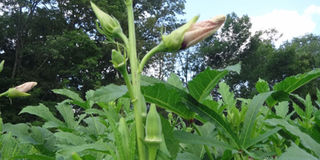Farming nutritious okra

I am planning to venture into okra farming. Kindly advise on the venture. Evans
Dear Evans
Okra is a herbaceous annual plant that is grown for its edible seed pods. It has small erect stems that can be bristly or hairless with heart-shaped leaves. They can grow up to 1.2-1.8m tall and as an annual plant, it survives only one season. It’s also known as lady’s fingers.
Okra’s young seed pods are eaten fresh or cooked as vegetable while dry seeds are used in oil extraction. Okra is a heat-loving plant that can do well in a greenhouse or hot areas.
Soil: It requires well-drained, light sandy to medium loams. The soil should be of high organic matter. The pH should range between 5.8 and 6.8.
Temperature: It should be grown in areas with high sunlight and grows in hot temperatures of at least 18.3°C.
Propagation: Okra is propagated from seeds and planted directly. To break dormancy to enhance germination, seeds are soaked in water together with optimiser overnight before planting.
Spacing: It’s planted in rows spaced at 60x45cm or 60×30cm.
Rates: Okra seed rate is 18 to 20kg/hectare for summer crop and 10 to 12kg for rainy season’s crop.
Thinning: Do it at a spacing of 15-22.5cm when they are four to six weeks old to reduce the final plant stand.
Maintenance: Okra requires moist soils. Water should be applied at a rate depending on evapotranspiration in a hot area, but in cooler climates, it requires less water as it tends to cool the plant restricting the growth.
Fertiliser application: Apply 220 kilogrammes together with Humipower at a rate of 1kg/50kg of fertiliser to reduce soil acidity, and improve soil structure. Well-composted manure can do well at one debe (tin) per 4m2. In case of chemical fertiliser, chicken manure can be spread on the farm a week before planting.
Weed control: Shallow cultivation can help control weeds after they emerge between crop rows. Cultivation is the most effective weed control method when properly timed.
Harvesting: Okra pods are ready for harvesting two months after planting.
I would like advice on how to make profits from my one acre. For now, I only plant maize. John
Dear John
You can try vegetable farming. Tomatoes, onions, capsicum, carrots, cucumbers, watermelon, chillies, cabbage, kales, indigenous vegetables such as amaranthus, spider plant, cowpea, and black nightshade.
Careful planning of layout and production should be next. In planning a vegetable farm, the following have to be considered:
• Decide on what to grow. This will depend on the demand, market and climate.
• Decide on which system you are going to use e.g. open vs. protected.
• Remember roads, irrigation pipelines or buildings are involved, thus if sited wrongly, such items will be difficult and expensive to shift.
• Work out the rotation plan to be followed and details of the cropping plan. This should be early.
• The cost of clearing and preparing land must be considered.
• It is important to plan for labour.
• If fencing or windbreak is needed, decide on the type and material.
• Decide on the location of the compost area and whether you will need a heap or pit.
It is necessary to provide a place for the disposal of organic debris and also serves as a source of organic matter.
It is close to the nursery, in an area which is unsuitable for crop production.
• For a nursery siting/area. Light shade are preferred. You may also build a lath house.
Preferably, nursery area should be at most two per cent of total area.
Will also need to decide on the type of nursery to use: seedbed or containerised. If seedbed, raise, flat or sunken.
• Irrigation and distribution method: Decide whether irrigation will be needed. If yes, decide on the system to be used and the water source.
I want to learn more about beef feedlot system. Please advise. Michael
Dear Michael
In the feedlot system, beef animals are concentrated on a farm with the main objective being fattening them for the market.
In this system, beef animals are fed on high-protein meals, given clean water all the time and all management practices for the animals put in place.
The beef breeds include The Ankole (bos taurus indicus), East African shorthorn Zebu (bos indicus), Angus, Charolais, Hereford, Simmental, Shorthorn, Sahiwal and Boran.




